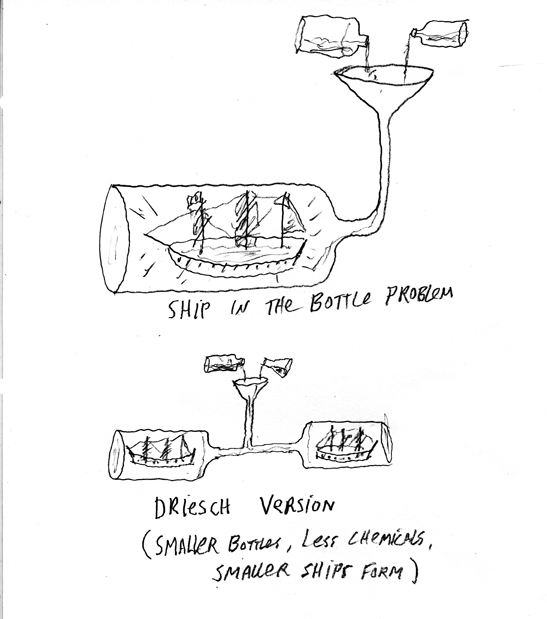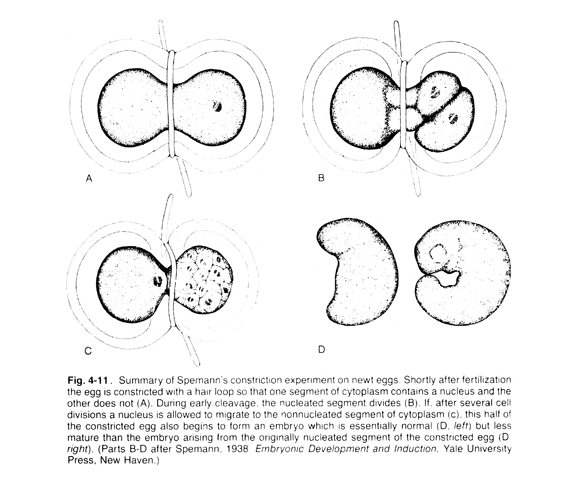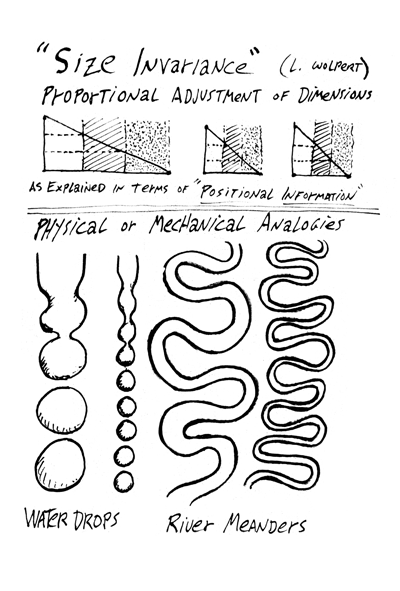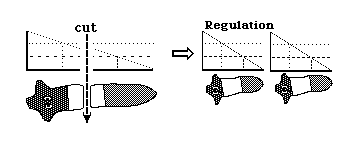Lecture Notes for Monday, January 28
"Embryonic Regulation"
Continuing from last Wednesday, remember that Hans Driesch discovered "regulative development" in the 1890s.He separated the first 2 cells of starfish embryos, and observed their development into two half-size plutei. When he separated the first 4 cells, each of the 4 developed into a quarter-size pluteus.
Separation into 8 cells at the 8-cell stage sometimes results in producing 1/8 size plutei. (But often results in abnormal larvae. Please guess what these abnormalities should be like)
Conversely, you can push two one-cell stages together and sometimes they will develop into double-sized plutei.
Regulation can succeed over a 16-fold range.

Slime mold fruiting body versus stalk regulation can succeed over more than a 100-fold range. (Probably a range of over a thousand-fold.)
However, if a Dictyostelium slug differentiates into stalk and spores very soon after the slug is cut into pieces, then sometimes you will get some fruiting bodies with a bigger stalk, (developing from cells that had been at the front of the slug, which form stalk cells) and other fruiting bodies develop with a proportionally bigger mass of spores. (which develop from amoebae that had been at the more rearward part of the slug)
Do you tend to expect that the mechanism of embryonic regulation will turn out to be basically the same in sea urchins as in slime molds?
...The same in echinoderms as in mammals?
...Can you suggest how regulation might work?
(What mechanism re-assigns the fates of cells?)
(How can this mechanism assign cell fates based not on measured distances,
but based on proportional distances?
For example, "measuring" 1/3 of the distance to the other side of the developing embryo)
Incidentally, the reason Driesch tried this experiment was to disprove a popular theory that different parts of embryos receiving different genes.
(In the late 1800s, that was guessed to be how differentiation was accomplished.)
Driesch was astonished by his discovery!
He concluded that embryos must be controlled by supernatural thinking beings ("entelechies")
--------------------
"Regulative" development contrasts with "mosaic" development, in which cell fates are irreversibly determined at early stages.
An extreme example of mosaic development are nematodes.
The nematode Caenorhabditis elegans is being used as a model organism to study many aspects of development, including aging.
Bob Goldstein discovered an example of regulation in an early stage of Caenorhabditis development. This was a very important discovery, and surprised many experts. Do you see why scientists expected that regulation would occur only in species whose development is regulative?
--------------------
What does the ability "to scale" tell us about normal mechanisms that cause organ formation? (to regulate proportional sizes of parts of the body?)
That's the big question. There might be several answers, or one. Whatever adjustments cause regulation of shape and adjustment of proportionality of sizes, sometimes requires time to adjust.
Spemann, Roux and Driesch asked the question whether cell differentiation works by distributing different genes to different cells of the embryo.
(Of course, we all know that isn't how differentiation works; but it had to be tested. It would not be impossible for differentiation to work that way; maybe life on some other planet uses that kind of method to cause cell differentiation.
(Actually, it is sort of surprising that method never evolved on earth.)
Spemann's experiment tying a human hair around an amphibian embryo at the one cell stage:

Briggs and King nuclear transplantation experiments. (in the 1950s)

Briggs and King removed the nuclei from unfertilized frog eggs, and then inserted single nuclei from a blastula at the 16-cell stage. Embryos developed, and all the different cell types of the body were formed, but they never got a whole, normal frog.
John Gurdon got a Nobel Prize for continuing these nuclear transplantation experiments, and succeeded in getting whole Xenopus frogs from eggs in which the original nucleus was inactivated and replaced with a transplanted one.
optional Wikipedia article about Gurdon's work
Older embryos can also be fused with each other and develop into animals that have tissues derived from both. Beatrice Mintz fused embryos from different strains of mice, producing mice with striped or otherwise distinguishable sections of fur. Such animals are chimeras, meaning that each individual cell was derived from only one of the fused embryos. Chimeras can be made in this way between mice and rats, and between sheep and goats. This is contrast to hybrid animals, in which each cell contains DNA from two different species (for example, a mule).
optional Wikipedia article about Mintz and her work
Even today scientists don't really understand the mechanism that changes the sizes of parts of embryos in proportion to the size of the whole embryo.

Lewis Wolpert proposed that chemical signals create gradients that determine what structures develop at each location in an embryo. The X, Y and Z coordinates of each location would be analogous to latitude, longitude and altitude. His "positional information" hypothesis is that diffusion gradients serve to adjust the size of parts in proportion to the size of the whole organism.
He has presented this as "The French Flag Model" in which gradients cause the red, white, and blue stripes in a flag to form in the same proportions regardless of the amount of starting material.

Lewis Wolpert's French Flag model applied to flatworms
This will be continued on Wednesday.
.